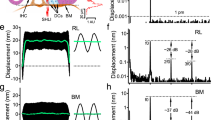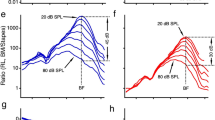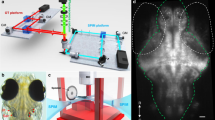Abstract
IN a recent communication1, one of us (O. L.) reviewed the results so far obtained, by the oscillographic method, in the study of the non-acoustic function of the vertebrate ear. In that review a preliminary account was given of the reaction to gravitational stimuli and linear accelerations of the otolith organ in the recessus utriculi of the elasmo-branch labyrinth. It was shown that the otolith organ of the utriculus is sensitive to positional changes about any horizontal axis, and to linear acceleration during straight-line translations. The fact that the organ is not restricted to respond to displacements in only one plane of space invited the conclusion that the utriculus may well be the only otolith organ concerned with the maintenance of equilibrium, leaving the otolith organs of the pars inferior of the labyrinth (sacculus and lagena) free for the reception of vibrational stimuli. This function has, in fact, been conclusively demonstrated to be localized in the pars inferior of the labyrinth of bony fish2,3.
This is a preview of subscription content, access via your institution
Access options
Subscribe to this journal
Receive 51 print issues and online access
$199.00 per year
only $3.90 per issue
Buy this article
- Purchase on Springer Link
- Instant access to full article PDF
Prices may be subject to local taxes which are calculated during checkout
Similar content being viewed by others
References
Lowenstein, O., Nature, 161, 652 (1948).
v. Frisch, K., Biol. Rev., 11, 210 (1936).
Dijkgraaf, S., Rev. suisse Zool., 55, 260 (1948).
Wever, E. G., and Bray, C. W., J. Exp. Psychol., 13, 373 (1930).
Derbyshire, A. J., and Davies, Amer. J. Physiol., 113, 476 (1935).
Adrian, E. D., Craik, K. J. W., and Sturdy, R. S., Proc. Roy. Soc., B, 125, 435 (1938).
Pumphrey, R. J., Nature, 143, 898 (1939).
Scarpa. A., "Anatomicæ disquisitiones de auditu et olfactu" (Ticini, 1789).
Author information
Authors and Affiliations
Rights and permissions
About this article
Cite this article
LOWENSTEIN, O., ROBERTS, T. Oscillographic Analysis of the Gravity and Vibration Responses from the Labyrinth of the Thornback Ray (Raja clavata). Nature 162, 852–853 (1948). https://doi.org/10.1038/162852a0
Issue Date:
DOI: https://doi.org/10.1038/162852a0
This article is cited by
-
?Neural? responses to acoustic stimulation after destruction of cochlear hair cells
Archives of Oto-Rhino-Laryngology (1979)
-
Die normale calorische Labyrinthreaktion
Archiv für Ohren- Nasen- und Kehlkopfheilkunde (1957)
-
Elektrophysiologische und histologische Untersuchungen im Vestibulariskerngebiet bei Drehreizen
Archiv für Ohren- Nasen- und Kehlkopfheilkunde (1954)
Comments
By submitting a comment you agree to abide by our Terms and Community Guidelines. If you find something abusive or that does not comply with our terms or guidelines please flag it as inappropriate.



